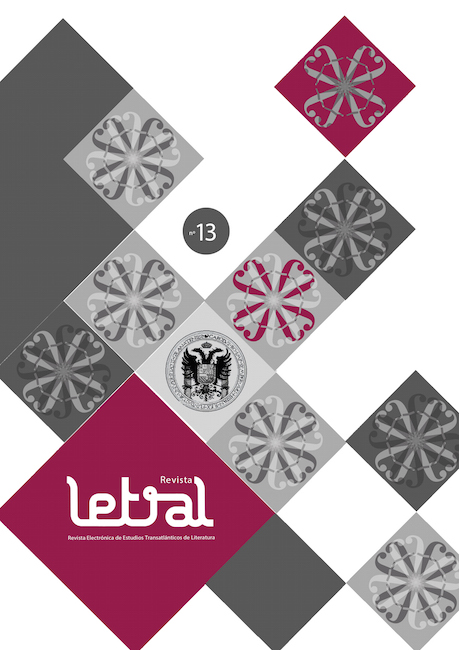Incorporated Vision: Artistic Critiques of the Development Discourse in Latin America
DOI:
https://doi.org/10.30827/rl.v0i13.3788Palabras clave:
Latina, Artes Visuales, Cuerpo, Visión, DesarrollismoResumen
Este ensayo analiza tres trabajos claves del arte latinoamericano en los años sesentas y setentas : La Destrucción (1963) de la artista argentina Marta Minujín, La Muerte del Justo y La Muerte del Pecador (1973) de la artista colombiana Beatriz González y Mandala (1969) de la artista brasilera Lygia Clark. Estas obras desdibujan las líneas entre el cuerpo del artista, el espectador o participante y la obra de arte, haciendo perceptible la constitución somática, histórica, social e ideológica de la visión. De tal modo, estas obras perforan el mito de la contemplación desinteresada u objetiva del racionalismo científico que sostuvo el discurso desarrollista y por lo tanto las relaciones de poder durante la Guerra Fría.Descargas
Citas
Bois, Yve-Alain and Lygia Clark (1994). “Nostalgia of the Body,” October,Vol. 69 (Summer), 85-109.
Calirman, Claudia (2012). Brazilian Art under Dictatorship: Antonio Manuel,Artur Barrio, and Cildo Meireles, Duke University Press.
Dunn, Christopher (2001). Brutality Garden, Tropicália and the Emergence of Brazilian Counterculture, University of North Carolina Press.
Escobar, Arturo (1995). Encountering Development: The Making and Unmaking of the Third World, Princeton N.J.: Princeton University Press.
Foucault, Michel (1982). “The Subject and Power,” Critical Inquiry, Vol. 8, No. 4 (Summer), 777-795.
Freire, Paolo (1968) 1996. Pedagogy of the Oppressed. London: Penguin Education.
Giunta, Andrea (2001). Vanguardia, internacionalismo y política: Arte argentino en los años sesenta, Buenos Aires, Barcelona, México: Paidós.
Katzenstein, Inés and Andrea Giunta (2004). Listen Here Now! Argentine Art of the 1960s Writings of the Avant-Garde. New York: The Museum of Modern Art.
LaDuke, Betty (1984). “Women and Art in Cuba: ‘Feminism Is Not Our Issue,’” Woman’s Art Journal, Vol 5, no. 2 (Autumn 1984 – Winter 1985), 34-40.
Lindauer, Margaret (1999). Devouring Frida: The Art History and Popular Celebrity of Frida Kahlo. Hanover: University Press of New England.
McCormack, Sabine (1991). Religion in the Andes: Vision and Imagination in Colonial Peru. Princeton. N.J.: Princeton University Press.
Mohanty, Chandra (1991). “Under Western Eyes: Feminist Scholarship and Colonial Discourses” in Third World Women and the Politics of Feminism. Mohanty, Russo and Torres eds. Bloomington and Indianapolis, Indiana University Press, 51-79.
Noorthoorn, Victoria, Minujín, Marta, and Museo de Arte Latinoamericano de Buenos Aires et al. (2010). Marta Minujín Obras 1959-1989, Buenos Aires: MALBA- Fundación Constantini.
O’Connor, Sister Mary Catherine (1942). The Art of Dying Well: The Development of the Ars Moriendi. New York: Columbia University Press.
Quiles, Daniel (2008). “Burn Out My Potentiality: Destruction and Collectivity in Greco and Minujín.” Beginning with a Bang! From Confrontation to Intimacy: Argentine Contemporary Artsits 1960-2007. New York: The Americas Society, 69-80.
Reyes, Ana María (2011). “Art at the Limits of Modernization: The Artistic Production of Beatriz González during the National Front in Colombia” Ph.D. Dissertation. Chicago: University of Chicago.
Rodríguez, Víctor Manuel (1996). “Los espejos de Beatriz González: modernismo,postcolonialidad e identificación.” In Historia Critica Revista del Departamento de Historia de la Facultad de Humanidades y Ciencias Sociales de la Universidad de los Andes, no. 13 (July–December), 21–31.
Sachs, Wolfgang (1992). A Development Dictionary, London: Zed Books.
Shildrick, Margrit and Janet Price (1999). “Openings on the Body: A Critical Introduction” in Feminist Theory and the Body: A Reader. New York: Routledge, 1-15.
Descargas
Publicado
Cómo citar
Número
Sección
Licencia
Revista Letral es una publicación de acceso abierto e inmediato totalmente gratuita, tanto para quien lee como para quien publica. Los autores y las autoras no pagan ningún tipo de tasa por el proceso editorial de sus artículos. Permitimos la lectura, descarga, copia, distribución, impresión, búsqueda, enlace o reutilización con fines no comerciales de todos los trabajos publicados, siempre que se citen la autoría, la revista y el órgano editor. Recomendamos encarecidamente la difusión de los artículos en redes sociales (Facebook, Twitter, LinkedIn, etc.) y científicas (ResearchGate, Academia.edu, etc.), repositorios institucionales universitarios y otros repositorios públicos, blogs y webs personales o institucionales, Google Scholar, ORCID, ResearchID, ScopusID, etc. En cualquier caso, la propiedad intelectual de los artículos y los posibles derechos económicos derivados de ellos son exclusivamente de sus autores.














